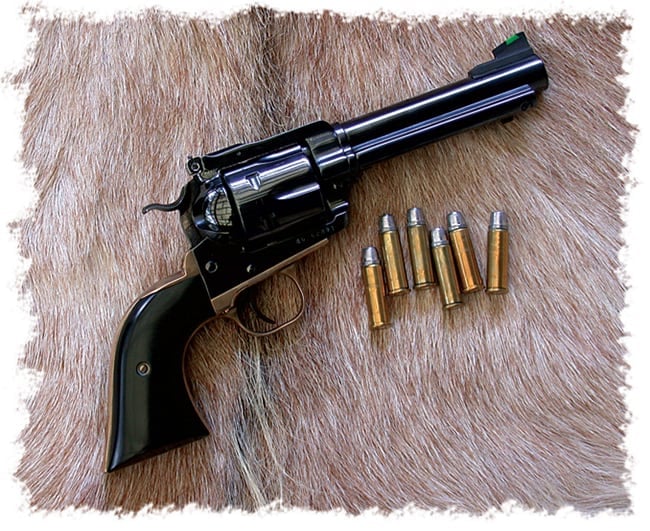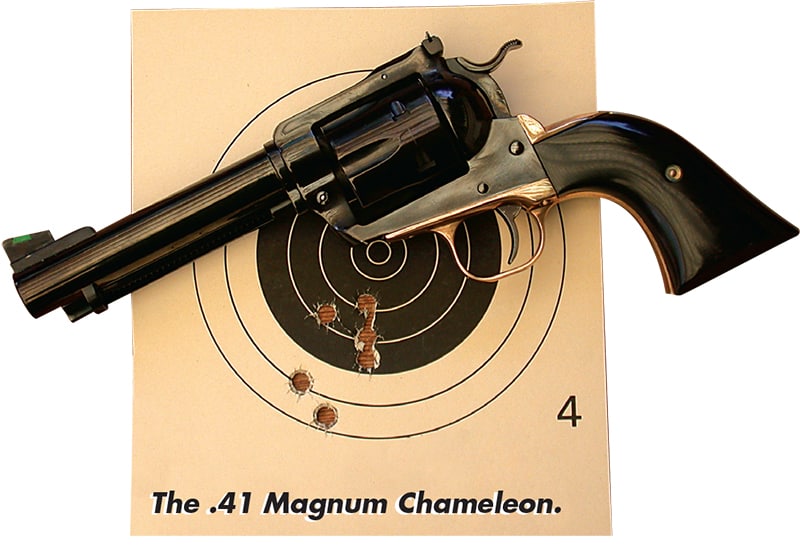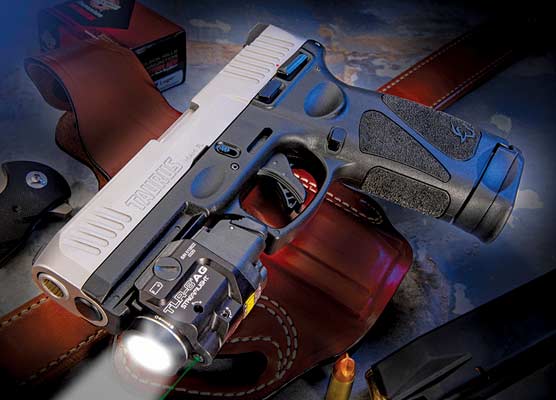QPR's Switch-Gun Sixgun
In the heyday of television westerns in the late 1950s, the most successful programs had a gimmick; it may have been the location, the character, or the firearms used. Johnny Ringo (Don Durant) carried a nine-shot LeMat in a spring clip holster from which he could always outdraw the bad guys. Josh Randall (Steve McQueen) carried the Mare’s Leg, a cut down Model 92 Winchester made to look like it used .45-70 rounds, and he was faster with this little rifle than anyone with a Single Action. Hoby Gilman (Robert Culp) had a real gimmick, he carried a Smith & Wesson New Model No. 3 instead of a Colt. Shotgun Slade (Scott Brady), of course, carried his namesake; and Lucas McCain (Chuck Connors) also went with a long gun instead of a sixgun, with his rapid firing, largeloop Model 92.
The greatest gimmick of all was used by John Payne as Vint Bonner in The Restless Gun. He could not decide if his gimmick was to be a sixgun or a long gun so he had one that was easily transformed one way or the other. His basic firearm was a short-barreled Colt SA. However, when he wanted to make a long shot he used what we call today a Buntline Special, complete with wire stock. Now none of this is amazing except for how he made the transition. He would reach into his saddlebags and pull out a long barrel, unscrew the short barrel of his sixgun, by hand no less, and then replace it with the longer barrel, all accomplished quick enough to make the necessary long shot. Anything is possible in the movies.
Try, Try Again
I vaguely remember another outfit, Centaur Systems in Northern Idaho I believe, at least planned to offer interchangeable barrels and cylinders on a Ruger New Model Blackhawk, however I don’t think they ever got very far. What they could not do Milt Morrison of Qualite Pistol and Revolver (QPR) is now doing.
Milt Morrison is one of the premier sixgunsmiths in the country. At one time he was the armorer for the California Highway Patrol, so he certainly knows his way around S&W revolvers, and he is also one of the few ’smiths capable of working on the Colt New Service and Texas Longhorn Arms revolvers. He is also well known for some of most beautiful bluing jobs this side of Smith & Wesson’s Bright Blue and Colt’s Royal Blue, both of which are long-gone history.
Success Achieved
The latest from Milt is something he has been working on for several years and is now ready to market. He calls it “The Chameleon,” a name his wife picked out and one he doesn’t particularly like, so we will see who wins the contest. At least for now, The Chameleon is built on a customer’s Ruger Blackhawk and consists of interchangeable cylinders and easily removable and replaceable barrels, which allow the shooter to switch calibers in just a few minutes. A full-blown Chameleon is made up of four cylinders chambered in .357, .41 and .44 Magnums as well as .45 Colt.
The prototype test Chameleon consists of four combinations. The .357 Magnum is represented by a 53⁄4″ Shilen barrel and matching cylinder; .41 Magnum, 5″ Shilen barrel and cylinder; .44 Magnum, 7″ Apex barrel and cylinder; and finally a 71⁄2″ .45 Colt Douglas barrel and corresponding cylinder. All barrels are marked on the barrel ring for caliber and each cylinder is marked on the rim end of the cylinder. Later Chameleons will have the caliber markings etched with bold numbers on the barrels and on two sides of the cylinders.
With the Chameleon, tolerances are such that it is impossible to match a large caliber cylinder with a small caliber barrel. By controlling the length of the cylinder as well as how far the barrel protrudes inside the frame window, they simply will not fit together. Going the other direction it’s possible for someone who is not paying attention to match a small caliber cylinder with a large caliber barrel, however if this happens, shooting a .357 down a .44 barrel only results in terrible accuracy.
What Makes It Work?
The heart of The Chameleon system is the patent-pending QPR barrel ring, which makes the quick-change process possible. The barrel ring on each barrel is forward of the threads and butts up against the mainframe as the barrel is screwed into place. This ring has two holes, one to accept the base pin and the other the ejector rod. To put everything together properly, The Chameleon comes with a barrel wrench with an adjustable stop and a sleeve that goes into the ejector rod hole. It is this sleeve and the base pin, which keeps the barrel in the proper position after it has been screwed into the frame with the proper torque.
The barrel wrench has an adjustable stop to prevent over-torquing. On the outside of the adjustment screw bracket there’s an Allen locking screw allowing the wrench to be adjusted. QPR has found, as expected, different people apply different pressure on the wrench, so it has been made adjustable so anyone can use it, by adding torque or lessening torque depending on the person and the adjustment. How important this is can be illustrated by the fact factory produced single-action revolvers from Colt and Ruger often have grip panels cracked on the inside simply because too much torque was applied to the screw when they were tightened.
Milt speaks to the versatility of his creation in saying his conversion system allows the shooter to change calibers on the same gun, and it is designed to exchange barrel and cylinder with ease in the field. This allows the trigger pull and general feel of the gun to remain the same of the activity.
Even Taffin Can Do It!
I have the soul of an artist not a mechanic or engineer so when it comes to computers and things mechanical I am definitely challenged. I know what I need to know when it comes to computers and having them work for me and I can totally strip and reassemble any single-action sixgun, even New Model Rugers, normally without needing a third hand; and thanks to a lot of good books I can do the same with many other firearms. However, I really admire those who can just look at anything mechanical and easily figure out how everything works. My handicap has its downside, of course, but for every down there is an up and the up in this case is if I can do it, anyone can, and when it comes to using this system, I can.
To assemble one particular caliber the barrel is screwed on hand tight, and then the barrel wrench is used to tighten the barrel until the stop on the wrench touches the frame. Over-tightening and applying too much torque will do for the barrel threads what-over tightening grip panels will do. Something has to give and the barrel threads can be pulled or stretched. This is how it’s possible to attach a 3rd Generation Colt barrel to a 2nd Generation Colt even though the threads are different as enough pressure allows them to conform to each other; even metal can be moved with enough pressure.
With The Chameleon it’s possible to see and feel the barrel ring line up properly with the frame. The check on proper alignment is whether or not the base pin can be inserted easily. If it will not, the barrel and mainframe alignment needs to be adjusted. If the pin enters freely, the second check is whether or not the extractor rod sleeve easily enters its hole in the frame. If both the sleeve and the base pin are easily inserted, alignment is correct. All this takes not only more time to explain than it does to accomplish, it is also not as complicated as it may sound.
Once the alignment is correct the cylinder is installed with the base pin, and using the provided combination cleaning rod and base pin extractor, screw the extractor sleeve onto the rod, seat it into the ejector rod housing hole, and remove the tool leaving the sleeve in the receiver. Install the ejector rod housing, ejector rod and spring as one unit into the ejector rod hole and secure with the ejector rod housing screw.
All of this sounds much more complicated than it really is and my all-thumbs turned into nimble fingers with a few practice runs. The use of plastic tape on the threads as used on water fittings helps to ensure a tight fit.
QPR says: “We have pre-set the barrel wrench and torqued the barrel to QPR Specifications however as each person has different upper-body strength we have made the barrel wrench adjustable to compensate for this.”
The Chameleon, including all barrels, cylinders and the mainframe are beautifully bright-blued as we have mentioned only QPR can do. This beautiful bluing is matched up with one of QPR’s brass grip frames fitted with black micarta grip panels, and the brass, blue and black micarta look really good together. QPR can also personalize any sixgun with the shooter’s name inscribed in fancy script and inlaid with gold if desired. The hammer is a modified Bisley-style that looks like it belongs on the standard Blackhawk frame. All barrels have black ramp-style front sights, with two barrels having green inserts resulting all in all in an extremely goodlooking sixgun.
Some favorite loads were run through each of the four Chameleon combinations. For five shots at 20 yards my best group with any of the calibers was BPR’s 187-grain gas-checked bullet over 13.0 grain of WW296 for right at 1,050 fps, and all shots in one ragged hole at 20 yards. Cast Performance Bullet Co.’s 187 grain gas checked LBT over 14.0 grains of H110 moves the muzzle velocity up to 1,230 fps and a most satisfying 11⁄8″ group.
In the .41 Magnum, Lyman’s #410459KT clocked out at 1,343 fps over 19.0 grains of #2400 and resulted in a 2″ group, while Cor-Bon’s 210 JHP at the same muzzle velocity grouped into 1 1/2″. My everyday workin’ load for the .44 Magnum is 10.0 grains of Unique or Universal. This time around with Hodgdon’s Universal, BRP’s 250-grain Keith-style gas check over 10.0 grains gave 1,175 fps and their 295 grain Keith-style over the same powder charge, 1,120 fps. Both loads put five shots into 11⁄4″ or less.
The Chameleon has several advantages. For traveling, everything fits into a standard-sized pistol case, and allows the use of four separate revolvers with a minimum of weight. When the gun limit beast rears its ugly head, as it’s won’t to do in some areas, The Chameleon allows you to have four revolvers counting as only one. Finally for the guy who has everything, now there is something completely different, giving pride of ownership in a quality conversion kit from a top gunsmith. It’s not just show — it’s also go.

Get More Revolver Content Every Week!
Sign up for the Wheelgun Wednesday newsletter here:









